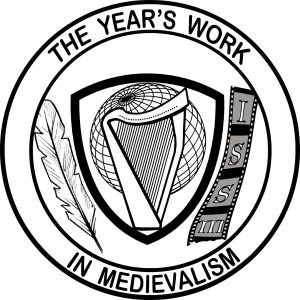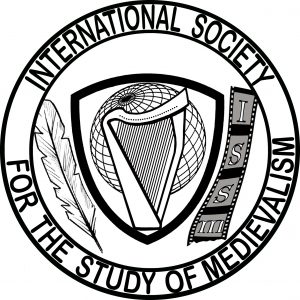Bryant White
Vanderbilt University
Introduction
In 1896, Edmond Picard, jurist and legal advisor to King Leopold II of Belgium, traveled across sub-Saharan Africa. Beginning on the West Coast and making his way towards the Congo Free State, the focal point of Leopold’s devastating colonial exploitation of African persons and land, Picard observed what he saw around him through decidedly racist lenses and catalogued his experiences in the autobiographical travel narrative En Congolie.1 One of the most striking moments in Picard’s narrative, from the perspective of both literary history and the history of medievalism(s), takes place when he uses the term cynocéphales to characterize a group of West Africans. This term, the French equivalent of the Latin cynocephali, is inscribed within a long history of literary othering, one that Picard, as not only a man of law but also of letters, undoubtedly knew well.
A survey of travel literature from the Middle Ages through the early modern period reveals a prolonged debate surrounding the existence of Pliny’s “monstrous races.” References to these, including the cynocephali, or dog-headed people, fill travel narratives of the medieval era. Unfortunately, little scholarly work has been done on allusions to the monstrous races in literature of the modern period. This study, attempting to help close that gap, will examine three travel narratives written in French during the nineteenth and twentieth centuries that make use of the cynocephali trope, albeit perhaps obliquely and with some degree of ambiguity. It will argue that, in each case, the trope is deployed in a racialized context and also that this type of appropriation has relevance today for medieval scholars. In our time, one might reflect analogously on the rise of the White Supremacy movement and its appropriation, in certain quarters, of medieval iconography and slogans.2
Moreover, the work of scholars such as Dorothy Kim, Debra Higgs Strickland, Jeffrey Jerome Cohen, Cord J. Whitaker, and Geraldine Heng, among others, have highlighted connections between modern racism and forms of racism at play in the Middle Ages, rendering the modern appropriation of the medieval less arbitrary. Indeed, Heng’s definition helps to answer remaining objections regarding whether one can legitimately apply the categories of “race” and “racism” to the Middle Ages.3 Heng argues:
“[R]ace” is one of the primary names we have—a name we retain for the strategic, epistemological, and political commitments it recognizes—attached to a repeating tendency, of the gravest import, to demarcate human beings through differences among humans that are selectively essentialized as absolute and fundamental, in order to distribute positions and powers differentially to human groups. Race-making thus operates as specific historical occasions in which strategic essentialisms are posited and assigned through a variety of practices and pressures, so as to construct a hierarchy of peoples for differential treatment.4
Race and what she terms “race-making” encompass much more, in Heng’s estimation, than mere reference to skin-color and other somatic traits. Rather, race and race-making take into account all means (whether via religion, politics, class structures, etc.) by which one group marks itself off differentially from another to signal its superiority. Yet, the body is never wholly absent from such signaling, and race-making discourses frequently utilize the physiognomic otherness of groups as markers of spiritual and moral inferiority in order to justify oppression.5 Cohen and Steel also affirm the role played by the body in medieval marking of difference across all spheres of life, stating that “medieval gender, class, origin and religion were produced through, sustained by and written upon the body, discerned in the flesh.”6 While race has “no biological or genetic reality,”7 it is nonetheless “real” as a complex web of strategies for structuring human relations. Debra Higgs Strickland highlights references to the monstrous races as one medieval race-making strategy, with those races displaying many traits that medieval Europeans also associated with real people groups, including “black Africans, Jews, Muslims, and Mongols.”8
Furthermore, Heng’s interpretation of the relationship between past and present, one in which “the past inhabits the present and haunts modernity and contemporary time,” explodes an overly “simple, linear” view of time with “modernity as telos,”9 allowing us to see how medieval “race-making” is relevant to modern racism and how modern racial categories are not entirely without relevance to medieval practices of othering. It represents what Sara Ahmed calls “a sedimented history,”10 where past racializing practices are never truly past but ever ready to be dangerously exploited and built upon.
A Brief History of Cynocephali
John Block Friedman, in his work on the monstrous races, has helpfully outlined a history of the cynocephali beginning in antiquity and continuing through the medieval period. The notion of cynocephali seems to find its first expression in the Western world by two Greeks, Ctesias and Megasthenes, who claimed to have travelled to India and to have seen there a variety of strange and marvelous peoples.11 Later apocryphal letters, supposedly written by Alexander the Great, confirmed the presence of these wondrous sights in India.12 Finally, the bulk of this learning was passed on to the Latin-speaking world through the work of Pliny and his own cataloguing of what eventually became known as the “Plinian races,” including pygmies, one-eyed men, and of course dog-headed people, along with many others. Friedman synthesizes these early sources into a working definition of the cynocephali:
They communicate by barking. Dressed only in animal skins, they live in caves and are fleetfooted hunters, using swords, bows, and javelins. In the Alexander cycle the Cynocephali—in addition to their other qualities—have huge teeth and breathe flames.13
In late antiquity, after the establishment of Christianity within the Roman Empire, conversion of the cynocephali garnered interest among missionaries. Exegeting Psalm 21:17—which, when given a Messianic and typological interpretation, refers to Christ’s crucifiers as dogs—early Christians applied the term to Jews and heretics.14They considered the dog-headed men as emblematic of heresy and doubt, cursed by God with a physical manifestation of their internal state. As human-animal hybrids their conversion would be spectacular, a sign of God’s spiritual victory over the enemies of the faith.15 Indeed, one such conversion story is later found in the person of Christopher, who experiences a prominent metamorphosis from dog-man to saint.
During the Middle Ages, debates surrounding the monstrous races interrogated their ontological status. Were they sub-human animals, and thus not specifically targeted by a gospel designed for the salvation of rational souls? Or were they essentially human, but rendered animal-like because of their sinful condition? If the latter, should they not be within the reach of salvation? Thomas of Cantimpré, for one, saw them as without souls, thus rendering moot soteriological questions.16 Others, like Ratramnus, viewed them as rational and, therefore, potentially savable.17
Moving out from theological literature, the discovery of monstrous races emerges as a nearly ubiquitous trope in medieval travel literature. To give but one example, we might turn to John Mandeville’s fourteenth-century account in his Livre des Merveilles du Monde of the arrival upon the isle of Nacumera:
qe est moult grant isle et bone et belle. [. . .] Et touz les hommes et femmes de celle isle ount testes de chiens et sont appellez Canopholez.18
that is a great isle and good and fair. [. . .] And all the men and women of that isle have hounds’ heads, and they be clept Cynocephales.19
Although Mandeville’s account shows the cynocephali existing in a relatively ordered society, not all descriptions are so positive. In other texts and works of art, dog-headed peoples are depicted as barbarous, savage, and base, frequently involved in the ingestion of human flesh, an act that casts them as “(uniquely) violent” and “draws attention to the canine head.”20 Indeed, we might speak of two ways in which the cynocephali function semiotically. First, on the literal level, their sheer physical strangeness saliently appears to the viewer of the art object or the reader, rendering the other of a distant land utterly foreign and somehow less-than-human. But secondly, there may be another more symbolic level of meaning. Karl Steel refers to the zoocephalic monsters in general as symbolizing “the upright, rational, bipedal form of the human governed by animal lusts and thus made morally monstrous.”21 Rational man thus yields his reason to be dominated by baser desires, signified by the animal head.
Finally, coming into the so-called “age of exploration,” we find that this particular trope does not altogether disappear from travel literature, although it does become less frequent. Rather, we find a desire to discover the monstrous races as well as a sense of disappointment that they are seemingly absent from the Americas. In describing the passing down of the premodern tradition regarding monstrous races, Lynn Ramey notes:
Renaissance appropriation of the medieval discourse on descriptions of Pliny’s monstrous races proves to be not a rupture with the medieval past, but rather its extension. Medieval travelers continually relocated the monstrous races to unexplored areas, and early modern explorers simply re-envisioned their placement in the newest of unexplored lands.22
Sought and not found in the New World, the Plinian races are reinterpreted by explorers of the sixteenth century as they seek to “read” New World peoples through the lens of premodern tropes. While “it became clearer that the New World peoples did not have dog heads or animal bodies,”23 early modern men still found ways of incorporating them into discourse shaped by premodern conceptualizations. In this way, as Ramey argues, “[d]ebates about humanness were transposed onto real people,”24 a transposition which then rendered justifications for colonialist destruction and exploitation plausible.
Cynocephali in Modernity: Colonialism and Race
From the preceding discussion it is clear that the notion of monstrous races was bound up with colonialism from the outset of the early modern period, and thus it is only reasonable to assume that references to it should continue throughout the following centuries. However, little has been written on allusions to monstrous races in much later texts. Only one study, a 2006 doctoral dissertation by Nicolas Médevielle, looks at references to the cynocephali in nineteenth-century literature, demonstrating that the trope was used well after the medieval period.25 Médevielle traces the parallel evolution of colonialism and notions of biological race, finding both in seed form in the medieval concept of “monstrous races” as well as in the othering and oppression engaged in by early European “explorers” of the Americas. The stated goal of the dissertation is to “examine the progressive racialization of Africans by French authors,” with racialization defined as “the historical process by which it became possible for French people to think of Africans not as human beings, but as creatures so far removed from themselves that they could be construed as substandard beings, akin to animals and monsters.”26 While Médevielle traces this historical process back to early modern and premodern sources, the monstrous races are more of a tangential rather than a central focus of his research. Moreover, the work of Heng and other medievalists cited above has shown that practices of race-making were far more pervasive and developed in the premodern period than Médvielle’s narrative might suggest.
One of the primary nineteenth-century texts treated by Médevielle is Jules Verne’s 1863 travel narrative Cinq Semaines en Ballon,27 a text within which Médevielle finds a reference to cynocéphales.28 Although this text does contain such a reference, it is not the only one from the period to do so. Moreover, the significance of the reference might be greater than Médevielle’s brief commentary on it would suggest. We will thus examine some relevant passages from this Verne novel, along with two other French texts from the late nineteenth and early twentieth centuries. Despite different formats (a novel, an autobiographical text, and a comic book), one could consider all three as examples of travel literature in some sense, texts that reveal a certain continuity with the medieval incarnation of that genre. Taken together, these texts might help to demonstrate that the medieval trope of cynocephali, as emblematic of the monstrous races, was taken up with renewed vigor in the context of modernity and colonialism’s highly racialized thought and practice.
Verne’s novel was written with colonialism already in full swing. Many Europeans upon the African continent were engaged ostensibly in a post-Enlightenment project of “knowledge-gathering,” but one that was bound up with colonization, constituting the geographical other as an (inferior) object of knowledge with the white colonizer as the (superior) subject.29 Such wielding of epistemic power often flew under the banner of “exploration.” Meanwhile, the reading public demanded such tales of the white “explorer” and his exploits. Verne’s narrative concerns three main characters (the scholar Dr. Samuel Fergusson, his valet Joe, and a hunter named Richard Kennedy) as they travel by hot-air balloon from East Africa to the continent’s West Coast.
At one point, while returning from a hunt, Kennedy and Joe spy from afar what they believe to be a group of Africans attacking Dr. Fergusson. The text initially describes this group with a racial slur and later as “some thirty individuals pressing together, gesticulating, yelling, and frolicking at the foot of the sycamore.”30 Dr. Fergusson uses a rifle to ward them off and shoots a figure perched in a tree, referred to by the text as “a large devil.”31 We are told that the figure’s “lifeless body” has fallen only to hang swinging from a branch, after which Joe asks, “how the devil is that animal hanging?”32 The use of the term “animal” is striking here, given that Joe and Kennedy still believe themselves to be dealing with Africans. Not until a few moments later does Joe realize that the figure before him is hanging by a tail and that they have actually encountered a group of apes, referred to in the French text first as singes, and then as cynocéphales.
Most English translations of this passage take an overly explanatory approach in representing our key term, choosing rather to refer to something like “baboons of the dog-faced species” than to use an English equivalent of the French cynocéphales.33 At the same time, this text admittedly raises a problem with the term. Indeed, it may also denote a species of baboon. Yet, a sort of semantic ambiguity or play here goes all the way back to the medieval period. H.W. Janson comments on this very phenomenon, noting that the distinction between dog-headed men and baboons was not always clearly recognized by medieval authors.34 Friedman reports Albert the Great’s speculation that “baboons or anthropoid apes may be behind the tales of barking, dog-headed peoples.”35 In 1836, the naturalist Jules Bergey de Xivrey, in his Traditions Tératologiques, also attempted to explain the bizarre sightings recounted by medieval travelers with recourse to baboons.36 Given the potential for overlap even in the Middle Ages between the categories of dog-headed men and baboons, later writers may have seen fit to exploit the double-referent of the term cynocéphales, perhaps with the premodern context in mind. Regarding the incident referenced above, a comparison is in fact clearly made between Africans and the cynocéphales. Kennedy tells Dr. Fergusson that they had at first believed him to have been under attack by natives, to which Dr. Fergusson replies, “they were only apes.” Kennedy retorts that “from far away, there is no great difference,” with Joe adding, “nor close at hand either.”37 Both Kennedy and Joe are clearly engaged in the de-humanization and animalization of Africans, recalling the debates on humanness that constituted such an important part of medieval and early modern race-making.
A later passage provides additional evidence that Verne was thinking of the medieval cynocephali trope while writing. Commenting on the many groups inhabiting this region of Africa, Kennedy says that a number of “scattered tribes come under the general title of Nyam-Nyams, and this noun is nothing less than an onomatopoeia. It reproduces the sound of chewing.”38 The following exchange between Kennedy and Joe ensues:
“Excellent,” said Joe, “Nyam! Nyam!”
“My dear Joe, if you were the immediate cause of this chewing, you wouldn’t find it so excellent.”
“What do you mean?”
“These tribes are considered to be man-eaters.”
“Is that certain?”
“Most certain. It had also been claimed that these natives had tails like simple quadrupeds, but it was soon recognized that this appendage belonged to the animal skins that they wore.”
“Too bad! A tail is rather nice for shooing away mosquitos.”
“It’s possible, Joe. But we must relegate all that to the realm of fables, just like the dogs’ heads that the traveler Brun-Rollet attributed to certain tribes.”
“Dogs’ heads? That’s convenient for barking, and even for man-eating!”
“What’s unfortunately been proven true is the ferocity of these populations, who are quite ravenous for the human flesh that they seek after so passionately.”39
The conjunction of cynocephali with anthropophagy again harks back to the medieval period. David Gordon White in Myths of the Dog-Man discerns the origin of this association in “medieval retellings of . . . the Alexander romance.”40 Freidman traces the desire for human flesh as far back as certain Greek incarnations of the myth.41 Importantly, the Verne passage contains at once a denial of the cynocéphale “fable,” while also recognizing that such stories existed well into the nineteenth century and were spread even by European travelers. Despite the denial of this myth in its literal meaning, its symbolic signification is kept intact. The Africans’ ferocious and uncontrollable appetite demands human flesh. Moreover, the onomatopoetic name Nyam-Nyam, by which the Europeans identify them, mimics the sound of chewing. In this othering and animalistic representation, Africans are defined by carnal desires and base appetites. Nyam-Nyam also calls to mind an earlier instance of racialized and derogatory labeling: the use of the repeated syllables bar-bar in the word barbaroi (from which we derive “barbarians”), employed by the ancient Greeks to identify onomatopoetically the seeming gibberish of non-Greeks.42 It thus inscribes itself, consciously or not, within a “sedimented history” of race-making going back to Antiquity.
We find that Picard’s En Congolie does something similar. Picard, as previously suggested, was an avowed racist and virulent anti-Semite,43 espousing a worldview that embraced a hierarchy of the races as its foundational principle. This comes across clearly in Picard’s theoretical writings on law. Picard argues for what he calls polygénisme: the notion that humanity is divided into “racial groups” that have “fundamental physical, but especially, cerebral differences.”44 He refers to race as the predominant, motivating factor in human existence and evolution, of which the law and legal reasoning are one manifestation.45 Furthermore, Picard authored a text which attempted to provide a legal justification for King Leopold II’s appropriation of the Congo as private property,46 in one of the most audacious and atrocious acts of colonialism ever undertaken. But Picard is a profoundly literary figure as well, having been a mentor to a burgeoning movement of young Belgian poets, novelists, and playwrights. Like Vern, therefore, he would certainly have been familiar with the tropes of premodern travel literature. An example of this familiarity appears in a passage toward the beginning of the text, in which Picard encounters a large group of West Africans boarding the same boat as himself. Referring to them with a racial epithet, he complains of how “they occupy the entire scene,” applying such depersonalized terms to them as a “prodigious heap” and an “abruptly-formed whirlwind.” Then, he proceeds to characterize them as animalistically violent in the following passage describing a scuffle:
They are ten, twenty, thirty, tangling their members, striking each other like chimes and throwing muffled punches, taking each other apart with grimaces like cynocephali, their dark and smooth-chinned faces like backwards sparrows, causing the palettes of their tongues, while wailing, to move between white teeth as carnivores incompletely cured of anthropophagy. No danger, moreover, that this brawl should create black or blue spots on their mahogany skin. It requires an officer throwing himself between them like a dog-trainer whipping a pack of hounds, taking away the brandished clubs and throwing them overboard, or handcuffing several of them.47
The passage again brings together cynocephali and anthropophagy to characterize a group of Africans. Racist and animalistic depictions such as these abound in Picard’s text, but this is the one occasion where the two tropes are referenced together. In addition, Picard clearly situates himself in continuity with the medieval tradition of travel narratives, as he will go on to compare himself to St. Brendan and parallel his own experience to that of the strange wonders recounted along Brendan’s voyage, thereby exoticizing the African continent through allusions to medieval mirabilia.48
Our final text, Zozo Explorateur,49 is part of a series of comic books designed by the Belgian artist Franchi and narrating the exploits of Zozo the monkey. In Zozo Explorateur, the titular character crash-lands upon an island inhabited by a myriad of different creatures, including a tribe of cynocéphales.50
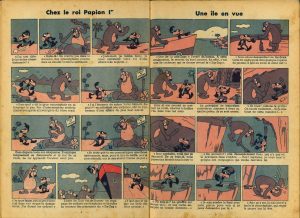
Figure 1: Zozo Explorateur, 4-5.
Once again, semantic ambiguity is at work here. Although there could be a reference to baboons, several elements seem to indicate that the premodern account of cynocephali is at least a subtext. For one thing, the illustration gives the creatures rather dog-like facial features. Additionally, they lack tails and are bipedal.
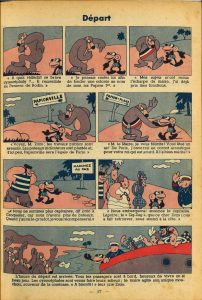
Figure 2: Zozo Explorateur, 27.
Finally, they are depicted anthropomorphically. In one image, the king of the cynocéphales poses like Rodin’s Thinker. Later, he declares the desire to found his own colony on the island. He sports a French tri-color sash and a club. These signal some form of human society and are consonant with a certain “teratologic strain” emphasizing the “the civilized quality” of the cynocephali.51 Thus, these cynocéphales seem to have more in common with the premodern human-animal hybrid than with mere baboons.
Another clue that the premodern background maybe be in view occurs when Zozo encounters Doctor Bigarreau, who transplants heads of one species to bodies of another. Could the cynocéphales have been the product of one of Dr. Bigarreau’s experiments, combining human and animal forms?
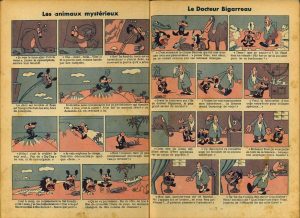
Figure 3: Zozo Explorateur, 6-7.
The text clearly racializes inhabitants of the island. At one point, Zozo meets a band of natives, stereotypically depicted as dark-skinned savages. They bear exaggerated traits (“bulbous nose, woolly hair, and open mouth with thick lips”52) not unlike those used in medieval iconography to portray Africans in a monstrous or demonic way, as Strickland has demonstrated with her brilliant analysis of “Ethiopians” in medieval art.53
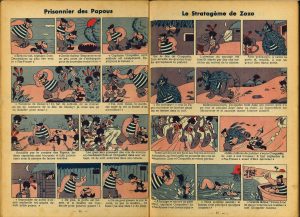
Figure 4: Zozo Explorateur, 14-5.
Their ferocious attack upon Zozo mirrors an equally ferocious attack by cynocéphales near the end of the story, effectively rendering the two tribes equivalent to one another and completing the transfer of animalistic attributes to the natives. Moreover, the cynocéphales do battle against a band of Arabs, themselves depicted with exaggerated and stereotypical features (pointed beards, vicious facial expressions, turbans, etc.) that conjure up the “Saracen,” perennial villain in the medieval European imaginary.54
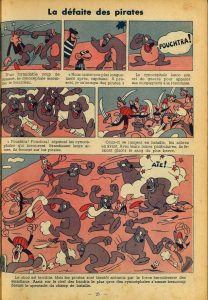
Figure 5: Zozo Explorateur, 25.
Conclusion
What can we learn from these texts as medieval scholars? It seems that they ought to give us pause and cause us to consider which medieval themes we appropriate in our own time and which we roundly reject. The appropriation of medieval motifs (such as cynocephali) in the ways depicted here represent a threat against which we must remain ever vigilant, particularly as contemporary white supremacists evoke their own hegemonically western and Caucasian form of “medievalism” to serve hate-filled agendas. As Heng and others have shown us, race-making does not magically disappear as we move further back into the past. It sometimes uses different strategies and takes different forms, but it is never less insidious. There is no premodern age of innocence—a medieval world without race-making is just as much a fantasy as the all-white Middle Ages dreamt of by the alt-right. If we allow medieval race-making tropes to be conscripted for modern racist ends (as they were by Verne, Picard, and Franchi), rather than engaging in critique of those tropes, then we endanger all attempts at “deprovincializing the Middle Ages”55 and undermine the work to establish more global and inclusive medievalisms.
- Edmond Picard, En Congolie (Brussels: Lacomblez, 1896).
- For a description of how medieval appropriation played out during the events at Charlottesville in 2017, see Josephine Livingstone, “Racism, Medievalism, and the White Supremacists of Charlottesville,” The New Republic, August 15, 2017, https://newrepublic.com/article/144320/racism-medievalism-white-supremacists-charlottesville. See also Amy Kaufman and Paul Sturtevant, The Devil’s Historians: How Modern Extremists Abuse the Medieval Past (Toronto: University of Toronto Press, 2020) for a recent scholarly work on how the Middle Ages have been weaponized throughout history for extremist and racist ends.
- See the articles devoted to this question (with scholars on both sides of the debate) in the special issue “Race and Ethnicity in the Middle Ages,” Journal of Medieval and Early Modern Studies 31, no. 1 (2001). See also Cord J. Whitaker, “Race-Ing the Dragon: The Middle Ages, Race and Trippin’ into the Future,” postmedieval 6, no. 1 (2015): 3–11, in which Whitaker traces the lasting influence of the 2001 JMEMS special issue while noting that the consensus is in and that the question has shifted from whether race exists in the Middle Ages to how. Finally, Kim offers a recent recapitulation of the debate as one between medieval scholars engaged in “premodern race denialism” and those engaged in “premodern critical race studies” in Dorothy Kim, “Introduction to Literature Compass Special Cluster: Critical Race and the Middle Ages,” Literature Compass 16, no. 9–10 (2019).
- Geraldine Heng, The Invention of Race in the European Middle Ages (Cambridge: Cambridge University Press, 2018), 27.
- Heng, Invention of Race, 72.
- Jeffrey Jerome Cohen and Karl Steel, “Race, Travel, Time, Heritage,” postmedieval 6, no. 1 (2015): 98-110, 100.
- Richard Delgado, Jean Stefancic, and Angela Harris, Critical Race Theory (Third Edition): An Introduction (New York: New York University Press, 2017), 9.
- Debra Higgs Strickland, Saracens, Demons, & Jews: Making Monsters in Medieval Art (Princeton, NJ: Princeton University Press, 2003), 59.
- Heng, Invention of Race, 20-2.
- Sara Ahmed, “Race as Sedimented History,” postmedieval 6, no. 1 (2015): 94–7.
- John Block Friedman, The Monstrous Races in Medieval Art and Thought (Cambridge, MA: Harvard University Press, 1981), 5.
- Friedman, Monstrous Races, 6-7.
- Friedman, Monstrous Races, 15.
- “For many dogs have encompassed me: the council of the malignant hath besieged me” (Douay-Rheims: Psalm 21:17); cf. “Dogs surround me, a pack of villains encircles me” (NIV: Psalm 22:16).
- Friedman, Monstrous Races, 61.
- Friedman, Monstrous Races, 183.
- Friedman, Monstrous Races, 188-9.
- John Mandeville, Le Livre des Merveilles du Monde (Paris: CNRS Editions, 2000), 350.
- John Mandeville, The Travels of Sir John Mandeville; the Version of the Cotton Manuscript in Modern Spelling (London: Macmillan and Co., 1923), 130.
- Spencer J. Weinreich, “How a Monster Means: The Significance of Bodily Difference in the Christopher Cynocephalus Tradition” in Monstrosity, Disability, and the Posthuman in the Medieval and Early Modern World, ed. Richard H. Godden and Asa Simon Mittman (Cham: Palgrave Macmillan, 2019), 181-207, 189.
- Karl Steel, How to Make a Human: Animals and Violence in the Middle Ages (Columbus: Ohio State University Press, 2011), 137. See also Strickland on this symbolic layer of meaning in Saracens, Demons, & Jews, 46-8.
- Lynn Ramey, “Monstrous Alterity in Early Modern Travel Accounts: Lessons from the Ambiguous Medieval Discourse on Humanness,” L’Esprit Créateur 48, no. 1 (2008): 81-95, 94.
- Ramey, “Monstrous Alterity,” 94.
- Ramey, “Monstrous Alterity,” 94.
- Nicolas Médevielle, “La Racialisation des Africains: Récits Commerciaux, Religieux, Philosophiques et Littéraires,1480-1880.” Ph.D. diss, Ohio State University, 2006.
- Médevielle, “La Racialisation des Africains,” ii.
- Jules Verne, Cinq Semaines en Ballon (Paris: Hachette, 1923).
- Médevielle, “La Racialisation des Africains,” 217-9.
- On the relationship of knowledge to power in the context of colonialism, see Edward W. Said, Orientalism (New York: Knopf Doubleday Publishing Group, 2014), 31-48. For a recent interaction with and deepening of Said’s critique on this specific point, see Wael Hallaq, Restating Orientalism: A Critique of Modern Knowledge (New York: Columbia University Press, 2018).
- All translations my own, unless otherwise noted. Verne, Cinq Semaines en Ballon, 97: “une trentaine d’individus se pressaient en gesticulant, en hurlant, en gambadant au pied du sycomore.”
- Verne, Cinq Semaines en Ballon, 98: “un grand diable.”
- Verne, Cinq Semaines en Ballon, 98: “par où diable se tient-il donc, cet animal?”
- See, for example, Five Weeks in a Balloon; or, Journeys and Discoveries in Africa, by Three Englishmen, trans. William Lackland (New York: Appleton & Co., 1869), 102-3.
- H. W Janson, Apes and Ape Lore in the Middle Ages and the Renaissance (London: Warburg Institute, 1952), 81-2.
- Friedman, Monstrous Races, 24.
- Jules Berger de Xivrey, Traditions Tératologiques, ou Récits de l’Antiquité et du Moyen Âge en Occident sur Quelques Points de la Fable, du Merveilleux et de l’Histoire Naturelle, Publiées d’Après Plusieurs Manuscrits Inédits (Paris: Imprimerie Royale, 1836), 87.
- Verne, Cinq Semaines en Ballon, 98-9: “– Nous t’avions cru assiégé par des indigènes. – Ce n’étaient que des singes, heureusement ! répondit le docteur. – De loin, la différence n’est pas grande, mon cher Samuel. – Ni même de près, répliqua Joe.”
- Verne, Cinq Semaines en Ballon, 152: “– Ces tribus éparses sont comprises sous la dénomination générale de Nyam-Nyam, et ce nom n’est autre chose qu’une onomatopée; il reproduit le bruit de la mastication.”
- Verne, Cinq Semaines en Ballon, 152-3: “– Parfait, dit Joe ; nyam ! nyam ! – Mon brave Joe, si tu étais la cause immédiate de cette onomatopée, tu ne trouverais pas cela parfait. – Que voulez-vous dire ? – Que ces peuplades sont considérées comme anthropophages. – Cela est-il certain ? – Très certain ; on avait aussi prétendu que ces indigènes étaient pourvus d’une queue comme de simples quadrupèdes ; mais on a bientôt reconnu que cet appendice appartenait aux peaux de bête dont ils sont revêtus. – Tant pis ! une queue est fort agréable pour chasser les moustiques. – C’est possible, Joe ; mais il faut reléguer cela au rang des fables, tout comme les têtes de chiens que le voyageur Brun-Rollet attribuait à certaines peuplades. – Des têtes de chiens ? Commode pour aboyer et même pour être anthropophage ! – Ce qui est malheureusement avéré, c’est la férocité de ces peuples, très avides de la chair humaine qu’ils recherchent avec passion.”
- David Gordon White, Myths of the Dog-Man (Chicago: University of Chicago Press, 1991), 55.
- White, Myths of the Dog-Man, 61.
- Andrew Gillett, “Barbarians, Barbaroi” in The Encyclopedia of Ancient History, ed. Roger S. Bagnall, Kai Broderson, Craige B. Champion, Andrew Erskine, and Sabine R. Huebner (West Sussex, UK: Blackwell Publishing, 2013), 1043.
- For his definitive treatise on anti-Semitism, see Edmond Picard, L’Aryano-Sémitisme (Belgium: Lacomblez, 1899).
- Edmond Picard, Les Constantes du Droit: Institutes Juridiques Modernes (Paris: Flammarion, 1921), 150. The passage in the original refers to “différences foncières physiques, et surtout cérébrales.”
- Edmond Picard, Le Droit Pur (Paris: Flammarion, 1919), 146-7; Edmond Picard, Synthèse de l’Antisémitisme (Bruxelles: Larcier, 1892), 12-4.
- Edmond Picard, État Independant du Congo: Consultation Délibérée (Bruxelles: Larcier, 1892).
- Picard, En Congolie, 43-4: “Ils sont dix, vingt, trente à enchevêtrer leurs membres, à se distribuer des claques sonnantes et des coups de poing sourds, à désarticuler en grimaces de pierrots à rebours, à faire mouvoir en miaulements les palettes de leurs langues rouges entre leurs dents blanches de carnivores mal guéris de l’anthropophagie. Pas de danger, du reste, que ces taloches fassent des noirs ou des bleus sur leur peau d’acajou. Il faut qu’un officier se jette sur eux comme un valet de chiens fouaillant une meute, arrache les matraques brandies et les jette par-dessus bord, ou cadenasse aux poignets de quelques-uns les fers de justice.”
- Picard, En Conglie, 45-6.
- Franchi, Zozo Explorateur (Paris: Touret, 1938).
- Alessandro Costantini, “Bande Dessinée Franco-Belge, Petit-Nègre Et Imaginaire Colonial,” Publifarum, no. 14 (2011), accessed June 17, 2019, http://www.farum.it/publifarum/ezine_articles.php?art_id=207. This was the only secondary source I found to mention the presence of cynocéphales in Zozo Explorateur.
- Steel, How to Make a Human, 143.
- 5252 Strickland, Saracens, Demons, & Jews, 82.
- Strickland, Saracens, Demons, & Jews, 79-93.
- See a discussion of “Saracens” and their stereotypical medieval depictions in Strickland, Saracens, Demons, & Jews, 157-88; see also Heng, Invention of Race, 110-80. For discussion of how “Saracen” is a racialized term, see Shokoofeh Rajabzadeh, “The Depoliticized Saracen and Muslim Erasure,” Literature Compass 16, no. 9-10 (2019), e12544, DOI 10.1111/lic3.12548.
- See Sharon Kinoshita, “Deprovincializing the Middle Ages” in The Worlding Project: Doing Cultural Studies in the Era of Globalization, ed. Rob Wilson and Christopher Leigh Connery (Santa Cruz: New Pacific Press, 2007), 61–75.

